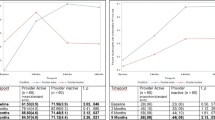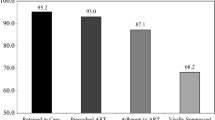Abstract
Treatment engagement, retention and adherence to care are required for optimal HIV outcomes. Yet, patients may fall below the treatment recommendations for achieving undetectable viral load or not be retained in care. This study examined the most challenging patients in Buenos Aires, Argentina, those non-adherent to HIV care. Men (n = 61) and women (n = 59) prescribed antiretrovirals (ARVs) and non-adherent to treatment in the prior 3–6 months were enrolled and assessed regarding adherence, knowledge, motivation and attitudes regarding treatment. Private clinic patients had lower viral load and higher self-reported adherence than public clinic patients. Motivations to be adherent and positive beliefs regarding ARVs were associated with increased adherence in public clinic participants. Increased self-efficacy was associated with increased adherence among participants from both clinics. Results support patient and provider interventions that strengthen the characteristics supporting adherence, engagement and retention in public and private clinic settings.
Resumen
El compromiso, la retención en el cuidado y adherencia al tratamiento son esenciales para el manejo óptimo del paciente con VIH. Sin embargo, muchos pacientes con VIH no siguen las el tratamiento para lograr tener una carga viral indetectable, o no permanecen bajo cuidado médico. Este estudio examina los pacientes más difíciles de retener en el cuidado médico en Buenos Aires, Argentina. Hombres (n = 61) y mujeres (n = 59) a los que se les habían recetado antiretrovirales pero seguían el tratamiento en los últimos 3 - 6 meses participaron en el estudio. Adherencia, conocimiento, motivación y actitudes frente al tratamiento fueron evaluados. Los pacientes en la clínica privada tenían menor carga viral y mejor adherencia que los de la clínica pública. Motivación y pensamientos positivos con respecto a antiretrovirales estaban asociados con mejor adherencia en los pacientes de la clínica pública. La autoeficacia estaba asociada con mejor adherencia en los pacientes en las dos clínicas. Los resultados indican que son necesarias intervenciones en pacientes y médicos para mejorar adherencia, compromiso y retención en el cuidado tanto en clínicas públicas como privadas.

Similar content being viewed by others
References
Organización Panamericana de la Salud (2013) Tratamiento antirretroviral bajo la lupa: un análisis de salud pública en Latinoamérica y el Caribe 2013. [cited 2014; Available from: http://www.paho.org/hq/index.php?option=com_docman&task=doc_view&gid=23711+&Itemid=999999&lang=es.
Ministerio de Salud de la Nación (2013) Boletín sobre el VIH-sida e ITS en Argentina, Buenos Aires. [cited 2014; Available from: http://www.msal.gov.ar/images/stories/bes/graficos/0000000325cnt-2014-01_sintesis-boletin-VIH-2013.pdf.
Crabtree-Ramirez B, Caro-Vega Y, Shepherd BE, Wehbe F, Cesar C, et al. Cross-sectional analysis of late HAART initiation in Latin America and the Caribbean: late testers and late presenters. PLoS One. 2011;6(5):e20272.
Mocroft A, Horban A, Clotet B, d’Arminio Monforte A, Bogner JR, et al. Regional differences in the risk of triple class failure in European patients starting combination antiretroviral therapy after 1 January 1999. HIV Med. 2008;9(1):41–6.
Mgbere O, Khuwaja S, Bell TK, Rodriguez-Barradas MC, Arafat R, et al. System and Patient Barriers to Care among People Living with HIV/AIDS in Houston/Harris County, Texas: HIV Medical Care Providers’ Perspectives. J Int Assoc Provid AIDS Care. 2014. doi: 10.1177/2325957414539045.
Kempf MC, McLeod J, Boehme AK, Walcott MW, Wright L, et al. A qualitative study of the barriers and facilitators to retention-in-care among HIV-positive women in the rural southeastern United States: implications for targeted interventions. AIDS Patient Care STDS. 2010;24(8):515–20.
Ballester R, Garcia S, Reinoso I, Campos A. Gender differences in adherence to treatment and illness behaviour in HIV-AIDS patients: an exploratory study in Spain. Int J Psychol Psychol Ther. 2002;2:219–36 Almería: Ed. AAC.
González JS, Penedo FJ, Antoni MH, Durán RE, Fernández MI. Social support, positive states of mind, and HIV treatment adherence in men and women living with HIV/AIDS. Health Psychol. 2004;23:413–8.
Ballester R. Adhesión terapéutica: revisión histórica y estado de la cuestión en la infección por VIH/SIDA. Revista de Psicopatología y Psicología Clínica. 2002;7:151–75 Madrid: Asociación Española de Psicología Clínica y Psicopatología y Ed.Dykinson.
Davila T, Pina Lopez, JA, Lopéz JJ, Sanchez-Sosa JJ (2008) Variables psicológicas y comportamientos de adhesión al tratamiento en personas con VIH: Un análisis en función del sexo. En S. Rivera A., R. Díaz L., R. Sánchez A. & I. Reyes L. (Coords.), La psicología social en México Vol. 12. México: AMEPSO, pp. 61–66.
Piña Lopez JA, Davila Tapia M, Sánchez-Sosa JJ, Cázares Robles O, Togawa C, et al. Efectos del tiempo de infección sobre predictores de adherencia en personas con VIH. Int J Psychol Psychol Ther. 2009;9:67–78.
Piña Lopez JA, Dávila Tapia M, Sánchez-Sosa JJ, Togawa C, Cázares Robles O. Asociación entre los niveles de estrés y depresión y la adhesión al tratamiento en personas seropositivas al VIH en Hermosillo, México. Revista Panamericana de Salud Pública. 2008;23:377–83.
Gordillo V, del Amo J, Soriano V, González-Lahoz J. Sociodemographic and psychological variables influencing adherence to antiretroviral therapy. AIDS. 1999;13(13):1763–9.
Sánchez-Sosa JJ, Piña Lopez JA, Corrales Robles AE (2008) Interacción entre la edad y variables psicológicas: Su influencia sobre los comportamientos de adhesión en personas seropositivas al VIH. En J. A. Piña y J. J. Sánchez-Sosa (Coords.), Aportaciones de la psicología al problema de la infección por VIH: Investigación e intervención. México: Universidad de Sonora, pp. 125–140.
Cataife G. Public versus private treatment of chronic diseases in seniors: Argentina, Brazil, Chile and Uruguay. Glob Public Health. 2012;7(10):1157–69.
Fisher JD, Amico KR, Fisher WA, Harman JJ. The information-motivation-behavioral skills model of antiretroviral adherence and its applications. Curr HIV/AIDS Rep. 2008;5(4):193–203.
Fisher JD, Fisher WA, Amico KR, Harman JJ. An information-motivation-behavioral skills model of adherence to antiretroviral therapy. Health Psychol. 2006;25(4):462–73.
Walsh JC, Mandalia S, Gazzard BG. Responses to a 1 month self-report on adherence to antiretroviral therapy are consistent with electronic data and virological treatment outcome. AIDS. 2002;16(2):269–77.
Johnson MO, Neilands TB, Dilworth SE, Morin SF, Remien RH, et al. The role of self-efficacy in HIV treatment adherence: validation of the HIV Treatment Adherence Self-Efficacy Scale (HIV-ASES). J Behav Med. 2007;30(5):359–70.
Raykov T. Estimation of composite reliability for congeneric measures. Appl Psychol Measure. 1997;21(2):173–84.
The LifeWindows Project Team (2006) The LifeWindows Information Motivation Behavioral Skills ART Adherence Questionnaire (LW-IMB-AAQ). Center for Health, Intervention, and Prevention. University of Connecticut.
Horne R, Weinman J. Patients’ beliefs about prescribed medicines and their role in adherence to treatment in chronic physical illness. J Psychosom Res. 1999;47(6):555–67.
De las Cuevas C, Rivero-Santana A, Perestelo-Perez L, Gonzalez-Lorenzo M, Perez-Ramos J, Sanz EJ. Adaptation and validation study of the beliefs about Medicines Questionnaire in psychiatric outpatients in a community mental health setting. Hum Psychopharmacol. 2011;26(2):140–6.
Ekstrand ML, Chandy S, Heylen E, Steward W, Singh G. Developing useful highly active antiretroviral therapy adherence measures for India: the Prerana study. J Acquir Immune Defic Syndr. 2010;53(3):415–6. doi:10.1097/QAI.0b013e3181ba3e4e.
Jones D, Cook R, Rodriguez A, Waldrop-Valverde D. Personal HIV knowledge, appointment adherence and HIV outcomes. AIDS Behav. 2013;17(1):242–9.
Beck AT, Steer RA, Brown GK. Manual for Beck Depression Inventory-II. San Antonio: Psychological Corporation; 1996.
Wang YP, Gorenstein C. Psychometric properties of the Beck Depression Inventory-II: a comprehensive review. Rev Bras Psiquiatr. 2013;35(4):416–31. doi:10.1590/1516-4446-2012-1048.
Brandt J, Benedict R. The Hopkins Verbal Learning Test-Revised. Lutz: Psychological Assessment Resources; 2001.
D’Elia LF, Satz P, Uchiyama CL. White T Color Trails Test Professional Manual. Odessa: Psychological Assessment Resources; 1996.
Tjur T. Coefficients of determination in logistic regression models—a new proposal: the coefficient of discrimination. Am Stat. 2009;63:366–72.
Beach MC, Keruly J, Moore RD. Is the quality of the patient-provider relationship associated with better adherence and health outcomes for patients with HIV? J Gen Intern Med. 2006;21(6):661–5.
Gonzalez JS, Batchelder AW, Psaros C, Safren SA. Depression and HIV/AIDS treatment nonadherence: a review and meta-analysis. J Acquir Immune Defic Syndr. 2011;58(2):181–7.
Saha S, Jacobs EA, Moore RD, Beach MC. Trust in physicians and racial disparities in HIV care. AIDS Patient Care STDS. 2010;24(7):415–20.
Piña Lopez JA, Gonzalez MT. Un modelo psicológico de adhesión en personas VIH+: modelamiento con ecuaciones estructurales. Revista Iberoamericana de Psicología y Salud. 2010;1(2):185–206.
Mallinson RK, Rajabiun S, Coleman S. The provider role in client engagement in HIV care. AIDS Patient Care STDS. 2007;21(Suppl 1):S77–84.
Acknowledgments
This study was funded by a grant from the NIMH/National Institutes of Health, R34MH097609, and was made possible with the support of the men and women participating.
Conflict of interest
The authors have no conflict of interest.
Author information
Authors and Affiliations
Corresponding author
Rights and permissions
About this article
Cite this article
Jones, D., Cook, R., Cecchini, D. et al. Examining Adherence Among Challenging Patients in Public and Private HIV Care in Argentina. AIDS Behav 19, 1619–1629 (2015). https://doi.org/10.1007/s10461-015-1037-7
Published:
Issue Date:
DOI: https://doi.org/10.1007/s10461-015-1037-7




